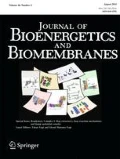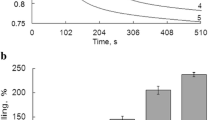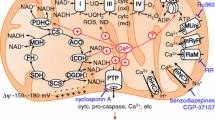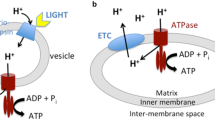Abstract
We demonstrate a suppression of ROS production and uncoupling of mitochondria by exogenous citrate in Mg2+ free medium. Exogenous citrate suppressed H2O2 emission and depolarized mitochondria. The depolarization was paralleled by the stimulation of respiration of mitochondria. The uncoupling action of citrate was independent of the presence of sodium, potassium, or chlorine ions, and it was not mediated by the changes in permeability of the inner mitochondrial membrane to solutes. The citrate transporter was not involved in the citrate effect. Inhibitory analysis data indicated that several well described mitochondria carriers and channels (ATPase, IMAC, ADP/ATP translocase, mPTP, mKATP) were not involved in citrate’s effect. Exogenous MgCl2 strongly inhibited citrate-induced depolarization. The uncoupling effect of citrate was demonstrated in rat brain, mouse brain, mouse liver, and human melanoma cells mitochondria. We interpreted the data as an evidence to the existence of a hitherto undescribed putative inner mitochondrial membrane channel that is regulated by extramitochondrial Mg2+ or other divalent cations.




Similar content being viewed by others
References
Akerman KE, Wikstrom MK (1976) Safranine as a probe of the mitochondrial membrane potential. FEBS Lett 68(2):191–197
Andreyev AY, Kushnareva YE, Starkov AA (2005) Mitochondrial metabolism of reactive oxygen species. Biochemistry (Mosc) 70(2):200–214
Babu AN, Cheng TP, Zhang A, Altura BT, Altura BM (1999) Low concentrations of ethanol deplete type-2 astrocytes of intracellular free magnesium. Brain Res Bull 50(1):59–62
Beavis AD (1992) Properties of the inner membrane anion channel in intact mitochondria. J Bioenerg Biomembr 24(1):77–90
Beavis AD, Brannan RD, Garlid KD (1985) Swelling and contraction of the mitochondrial matrix. i a structural interpretation of the relationship between light scattering and matrix volume. J Biol Chem 260(25):13424–13433
Bijak M (1989) Daily and seasonal variations in Na+, K+, Ca2+ and Mg2+ contents in the cingulate cortex of the mouse brain. Folia Biol (Krakow) 37(1–2):3–11
Chinopoulos C, Zhang SF, Thomas B, Ten V, Starkov AA (2011) Isolation and functional assessment of mitochondria from small amounts of mouse brain tissue. Methods Mol Biol 793:311–324
Dordick RS, Brierley GP, Garlid KD (1980) On the mechanism of A23187-induced potassium efflux in rat liver mitochondria. J Biol Chem 255(21):10299–10305
Durham AC (1983) A survey of readily available chelators for buffering calcium ion concentrations in physiological solutions. Cell Calcium 4(1):33–46
Fiskum G, Kowaltowksi AJ, Andreyev AY, Kushnareva YE, Starkov AA (2000) Apoptosis-related activities measured with isolated mitochondria and digitonin-permeabilized cells. Methods Enzymol 322:222–234
Garlid KD, Beavis AD (1986) Evidence for the existence of an inner membrane anion channel in mitochondria. Biochim Biophys Acta 853(3–4):187–204
Goldberg ND, Passonneau JV, Lowry OH (1966) Effects of changes in brain metabolism on the levels of citric acid cycle intermediates. J Biol Chem 241(17):3997–4003
Helpern JA, Vande Linde AM, Welch KM, Levine SR, Schultz LR, Ordidge RJ, Halvorson HR, Hugg JW (1993) Acute elevation and recovery of intracellular [Mg2+] following human focal cerebral ischemia. Neurology 43(8):1577–1581
Howse DC, Duffy TE (1975) Control of the redox state of the pyridine nucleotides in the rat cerebral cortex. effect of electroshock-induced seizures. J Neurochem 24(5):935–940
Jaburek M, Yarov-Yarovoy V, Paucek P, Garlid KD (1998) State-dependent inhibition of the mitochondrial KATP channel by glyburide and 5-hydroxydecanoate. J Biol Chem 273(22):13578–13582
Korshunov SS, Skulachev VP, Starkov AA (1997) High protonic potential actuates a mechanism of production of reactive oxygen species in mitochondria. FEBS Lett 416(1):15–18
Kowaltowski AJ, Vercesi AE, Fiskum G (2000) Bcl-2 prevents mitochondrial permeability transition and cytochrome c release via maintenance of reduced pyridine nucleotides. Cell Death Differ 7(10):903–910
Miyake S, Yamashita T, Taniguchi M, Tamatani M, Sato K, Tohyama M (2002) Identification and characterization of a novel mitochondrial tricarboxylate carrier. Biochem Biophys Res Commun 295(2):463–468
Palmieri F (2004) The mitochondrial transporter family (SLC25): physiological and pathological implications. Pflugers Arch 447(5):689–709
Peixoto PM, Ryu SY, Kinnally KW (2010) Mitochondrial ion channels as therapeutic targets. FEBS Lett 584(10):2142–2152
Peixoto PM, Dejean LM, Kinnally KW (2012) The therapeutic potential of mitochondrial channels in cancer, ischemia-reperfusion injury, and neurodegeneration. Mitochondrion 12(1):14–23
Quagliariello E, Palmieri F (1968) Control of succinate oxidation by succinate-uptake by rat-liver mitochondria. Eur J Biochem 4(1):20–27
Robinson BH, Chappell JB (1970) The kinetics of tricarboxylate anion oxidation by rat liver mitochondria in relation to the availability of L-malate. Biochim Biophys Acta 205(2):300–303
Sims NR (1990) Rapid isolation of metabolically active mitochondria from rat brain and subregions using percoll density gradient centrifugation. J Neurochem 55(2):698–707
Starkov AA (2008) The role of mitochondria in reactive oxygen species metabolism and signaling. Ann N Y Acad Sci 1147:37–52
Starkov AA (2010) Measurement of mitochondrial ROS production. Methods Mol Biol 648:245–255
Starkov AA, Fiskum G, Chinopoulos C, Lorenzo BJ, Browne SE, Patel MS, Beal MF (2004) Mitochondrial alpha-ketoglutarate dehydrogenase complex generates reactive oxygen species. J Neurosci 24(36):7779–7788
Tretter L, Adam-Vizi V (2004) Generation of reactive oxygen species in the reaction catalyzed by alpha-ketoglutarate dehydrogenase. J Neurosci 24(36):7771–7778
Vogel R, Wiesinger H, Hamprecht B, Dringen R (1999) The regeneration of reduced glutathione in rat forebrain mitochondria identifies metabolic pathways providing the NADPH required. Neurosci Lett 275(2):97–100
Acknowledgments
This work was supported in part by the National Institutes of Health/National Institute on Aging grant PO AG 14930 to A.A.Starkov, by Ministry of Education and Science of Russian Federation (state assessment 6.149.2014/К) to V.N.Popov, and by the MTA-SE Lendület Neurobiochemistry Research Division 95003 and OTKA K 100918 to C. Chinopoulos.
Author information
Authors and Affiliations
Corresponding author
Rights and permissions
About this article
Cite this article
Starkov, A.A., Chinopoulos, C., Starkova, N.N. et al. Divalent cation chelators citrate and EDTA unmask an intrinsic uncoupling pathway in isolated mitochondria. J Bioenerg Biomembr 49, 3–11 (2017). https://doi.org/10.1007/s10863-016-9656-x
Received:
Accepted:
Published:
Issue Date:
DOI: https://doi.org/10.1007/s10863-016-9656-x




